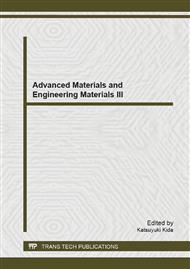[1]
Z. Ma, X. Zheng, W. Liu, X. Lin, and W. Deng, Fast thermal resistance measurement of high brightness LED, in Electronic Packaging Technology, 2005 6th International Conference on, 2005, pp.1-3.
DOI: 10.1109/icept.2005.1564685
Google Scholar
[2]
G. Rong-feng, T. Da-lei, W. Xing, and Z. Wen-qing, Thermal, mechanical and optical analysis of SiC-based LED, in Electronics Packaging Technology Conference, 2008. EPTC 2008. 10th, 2008, pp.939-944.
DOI: 10.1109/eptc.2008.4763550
Google Scholar
[3]
X. Luo, R. Hu, T. Guo, X. Zhu, W. Chen, Z. Mao, and S. Liu, Low thermal resistance LED light source with vapor chamber coupled fin heat sink, in Electronic Components and Technology Conference (ECTC), 2010 Proceedings 60th, 2010, pp.1347-1352.
DOI: 10.1109/ectc.2010.5490645
Google Scholar
[4]
H. H. Cheng, D. -S. Huang, and M. -T. Lin, Heat dissipation design and analysis of high power LED array using the finite element method, Microelectronics Reliability, vol. 52, pp.905-911, (2012).
DOI: 10.1016/j.microrel.2011.05.009
Google Scholar
[5]
Y.F. Su, S.Y. Yang, T.Y. Hung, C.C. Lee, and K.N. Chiang, Light degradation test and design of thermal performance for high-power light-emitting diodes, Microelectronics Reliability, vol. 52, pp.794-803, (2012).
DOI: 10.1016/j.microrel.2011.07.059
Google Scholar
[6]
K. Zhang, D. Xiao, X. Zhang, H. Fan, Z. Gao, and M. M. Yuen, Thermal performance of LED packages for solid state lighting with novel cooling solutions, in Thermal, Mechanical and Multi-Physics Simulation and Experiments in Microelectronics and Microsystems (EuroSimE), 2011 12th International Conference on, 2011, p.1.
DOI: 10.1109/esime.2011.5765839
Google Scholar
[7]
Z. Sauli, V. Retnasamy, R. Vairavan, W. M. W. N. Haimi, H. Kamarudin, Y. Neoh Fung, and N. Khalid, Solid State Lighting Stress and Junction Temperature Evaluation on Operating Power, in Computer Modelling and Simulation (UKSim), 2013 UKSim 15th International Conference on, 2013, pp.290-293.
DOI: 10.1109/uksim.2013.127
Google Scholar
[8]
R. Vairavan, Z. Sauli, V. Retnasamy, R. C. Ismail, N. I. M. Nor, N. S. Nadzri, and H. Kamarudin, High Power LED Thermal and Stress Simulation on Copper Slug, in Computer Modelling and Simulation (UKSim), 2013 UKSim 15th International Conference on, 2013, pp.294-298.
DOI: 10.1109/uksim.2013.150
Google Scholar
[9]
M.H. Chang, D. Das, P. V. Varde, and M. Pecht, Light emitting diodes reliability review, Microelectronics Reliability, vol. 52, pp.762-782, (2012).
DOI: 10.1016/j.microrel.2011.07.063
Google Scholar


